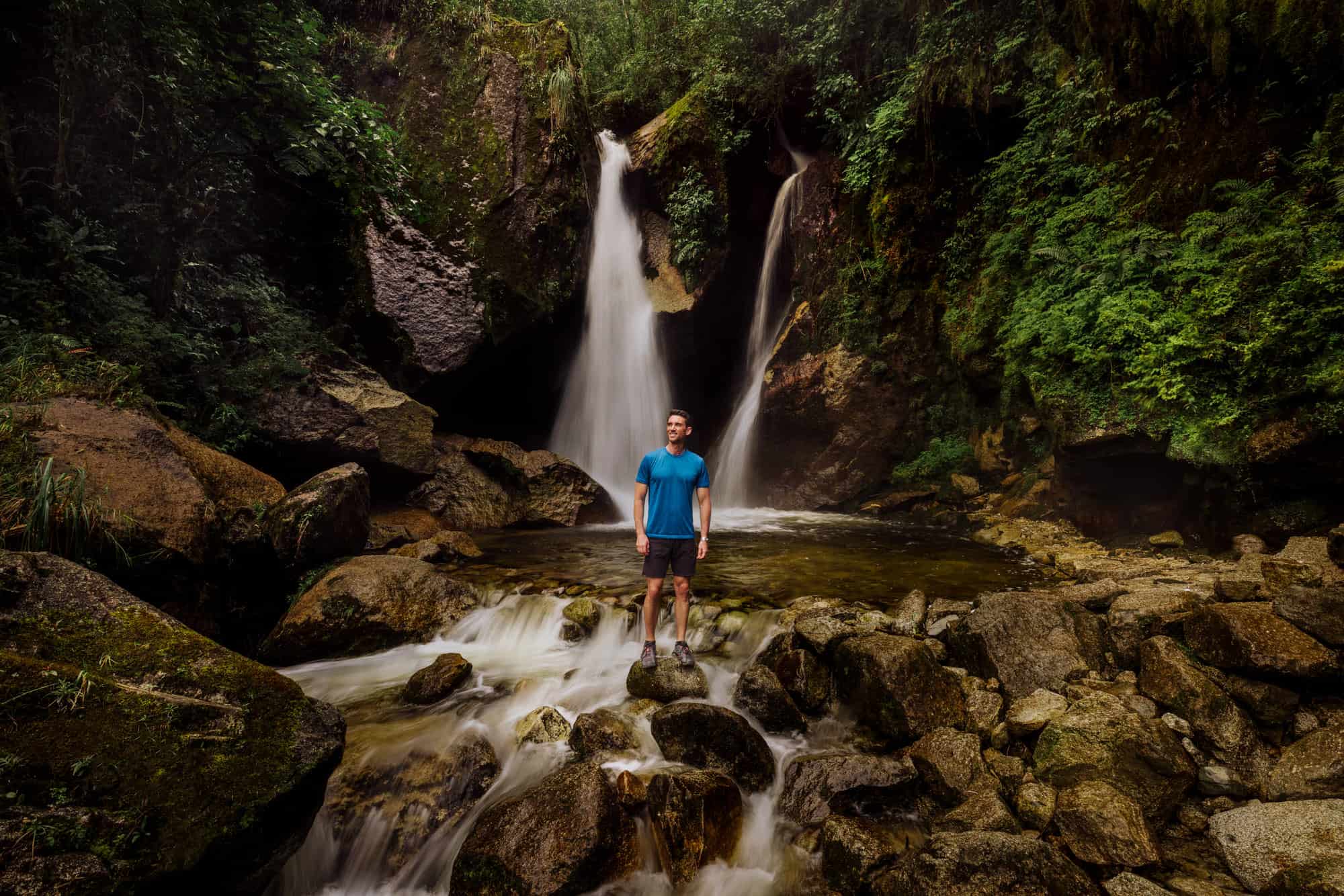Aguas Calientes Peru: A Guide to Hotels, Trains, & Things to Do

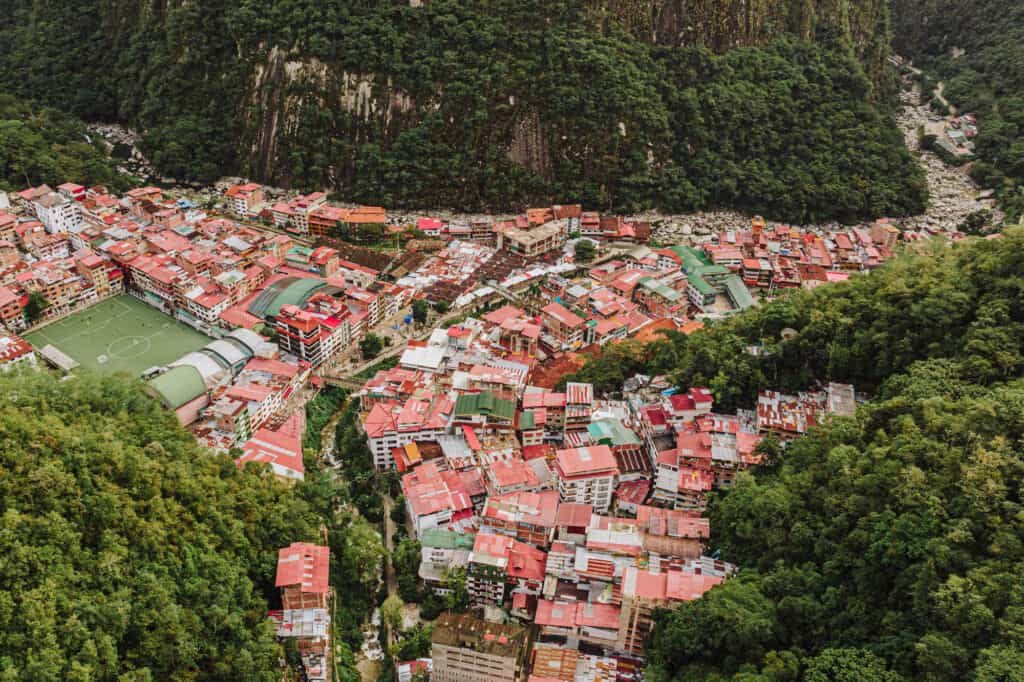
On my first visit to Aguas Calientes, Peru, I was disappointed that we were only there for a day trip!
As is the case with most people who visit the small town nestled in a valley in the Andean Mountains, we were there to see Machu Picchu. But Aguas Calientes, or Machu Picchu Pueblo, is a charming, bustling place on its own.
It’s well worth a couple of nights, even if your main destination is the world-famous Inca site up the hill!
I’ll go over the hotel options, restaurants, things to do, plus how to use Aguas Calientes as a base for your visit to Machu Picchu.
Where to Stay in Aguas Calientes Peru
Aguas Calientes exists almost entirely as a gateway for tourists to use as a base to visit Machu Picchu. So it’s full of rentals and hotels!
You can use the interactive map below to plug in your dates to see rates for your stay:
While the map might appear to represent a larger city, the town is entirely walkable.
One of the newer hotels is the El MaPi by Inkaterra.
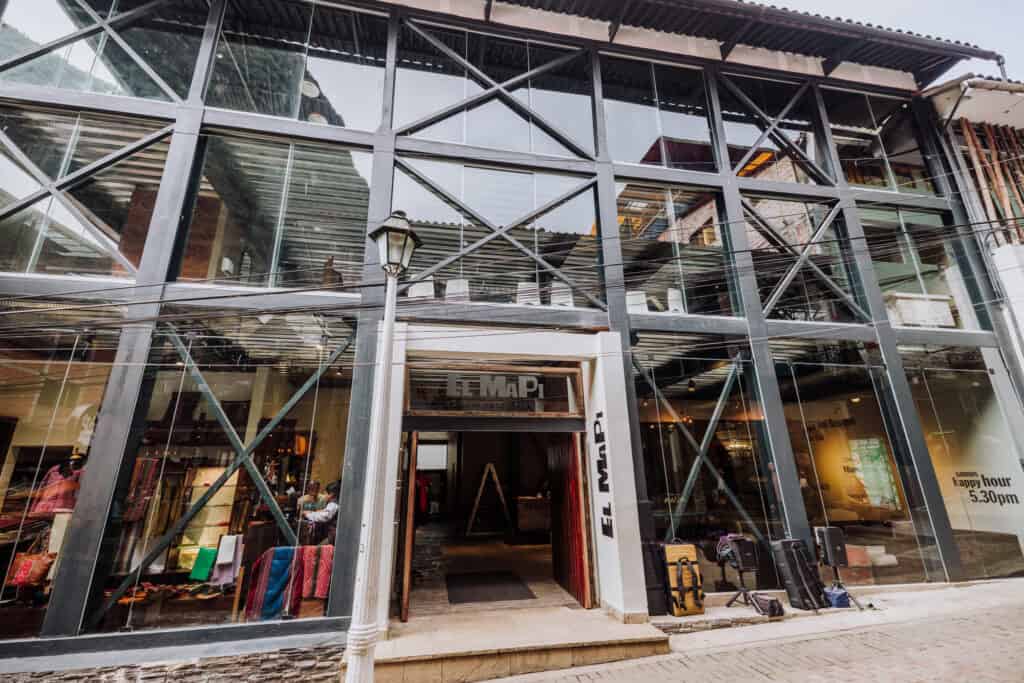
They try a bit too hard to be “hip” in the room designs. (I don’t need wall art telling me it’s 5:00 and happy hour somewhere.) But the rooms are clean, and the restaurant serves an excellent breakfast spread!
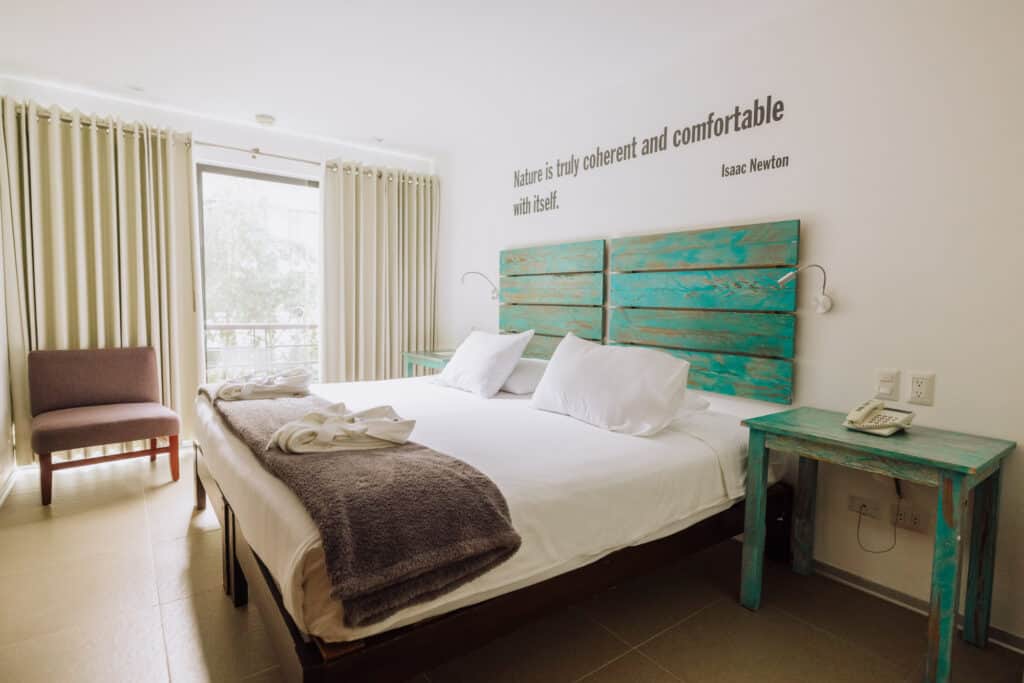
They’ll also hold your luggage for the day after you checkout if you’re looking to spend more time in town before catching your train.
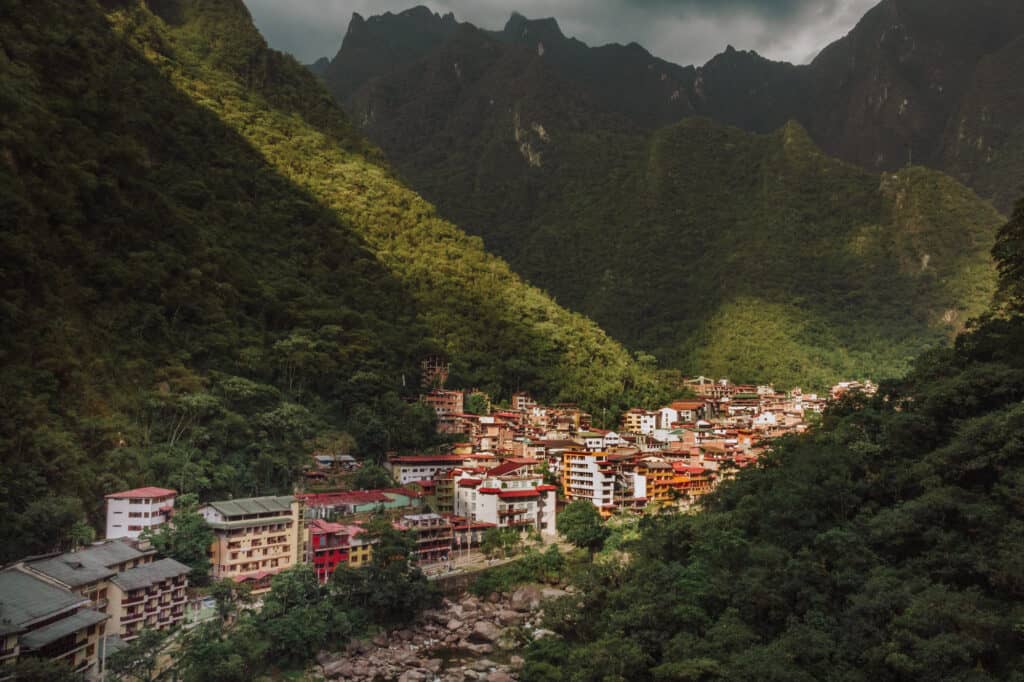
Getting to Aguas Calientes: Hired Guides
While I’ll explain in detail how manageable it is to get from Cusco to Aguas Calientes on your own, it’s totally understandable if you’re looking for someone else to deal with the hassle and logistics!
With that in mind, this is a highly-rated, excellent option:
➡️ Click to Book: Cusco to Aguas Calientes
- 2-day tour, including all transport and trains, entrance to Machu Picchu, hotel in Aguas Calientes, and a guide.
The Train to Aguas Calientes Peru
Traveling from Cusco to Aguas Calientes by train is a popular and scenic way to reach the gateway to Machu Picchu.
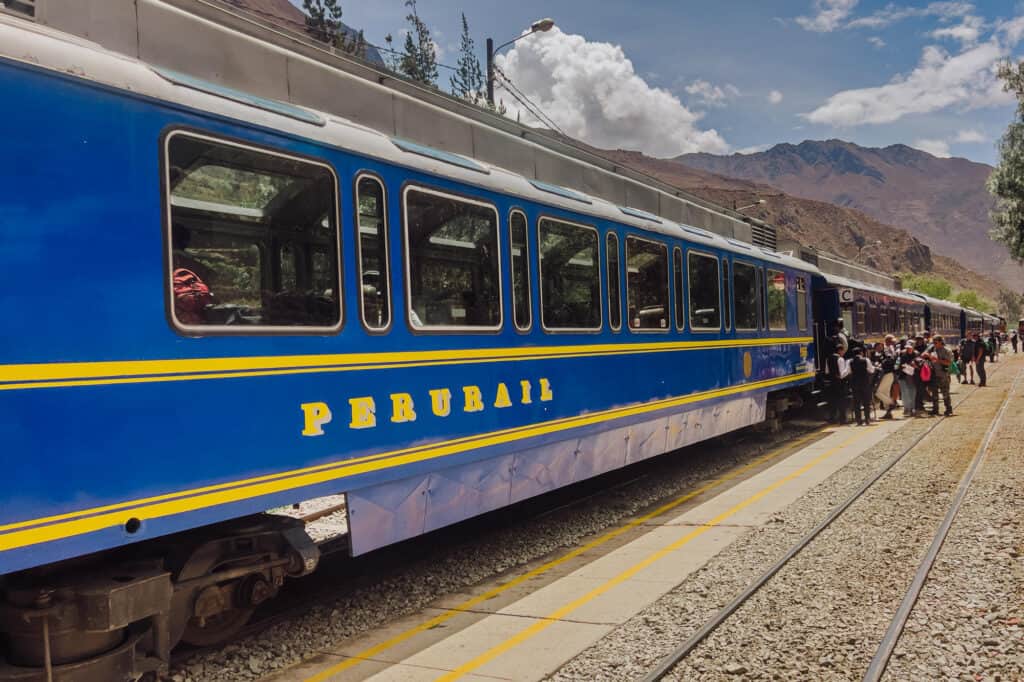
There are different train options provided by two main train companies: PeruRail and Inca Rail.
The cost of a ticket will vary, depending on the time, day, and level of service.
We generally take the Vistadome on PeruRail, which usually runs around $100 USD per ticket.
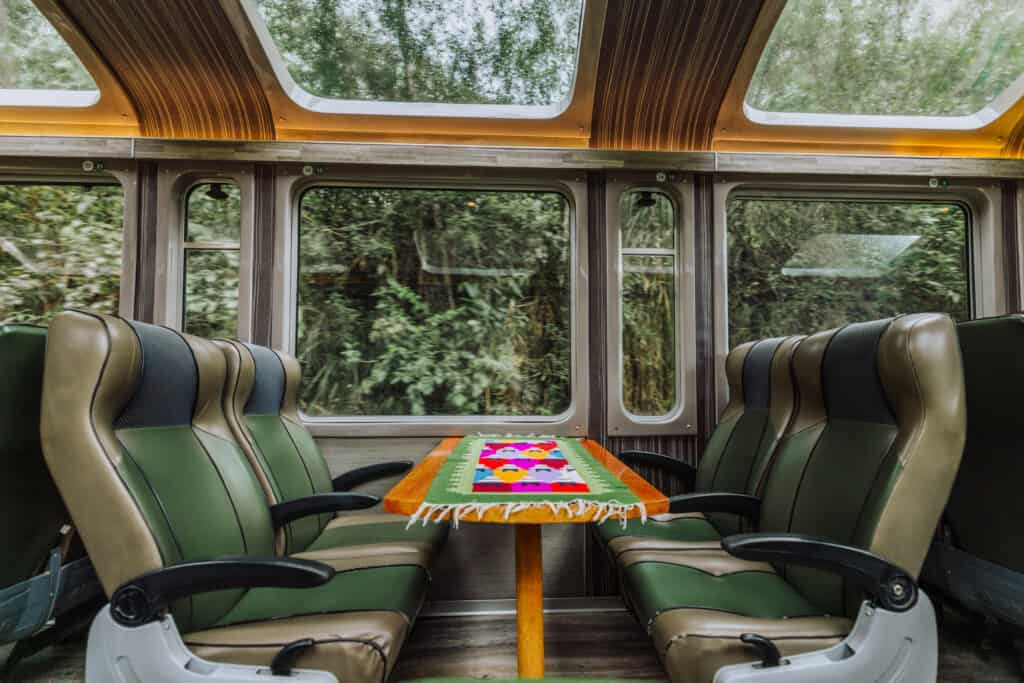
Here’s an overview of the train options:
PeruRail:
The Expedition Train
- This is PeruRail’s budget-friendly option.
- Comfortable seating with large panoramic windows to enjoy the scenic views.
- Snacks and beverages are available for purchase onboard.
The Vistadome Train:
- Offers panoramic windows and glass ceilings for a more immersive experience of the surrounding landscapes.
- Larger, more comfortable seats compared to the Expedition Train.
- Snacks and beverages are served, and there’s often entertainment onboard.
Belmond Hiram Bingham:
- A luxury train experience with elegant interiors and top-notch service.
- Gourmet dining is included, as well as beverages.
- Live music and entertainment on board.
- Bus transportation from Aguas Calientes to Machu Picchu is also included.
Inca Rail:
The Voyager Train:
- Inca Rail’s standard service.
- Comfortable seating with large windows.
- Snacks and beverages are available for purchase.
360° Train:
- Offers panoramic windows and skylights for excellent views.
- Larger and more comfortable seats than the Voyager Train.
- Snacks and beverages are included.
First-Class Train:
- Inca Rail’s premium service.
- Features larger seats with tables for added comfort.
- Gourmet meals and beverages are included.
- Bus transportation from Aguas Calientes to Machu Picchu is provided.
Cusco to Aguas Calientes
- Duration: The train journey takes approximately 3 to 4 hours, depending on the departure station in Cusco and type of train.
- Booking: It’s advisable to book train tickets in advance, especially during peak tourist seasons. Tickets can be purchased directly from the PeruRail or Inca Rail websites or through authorized agents.
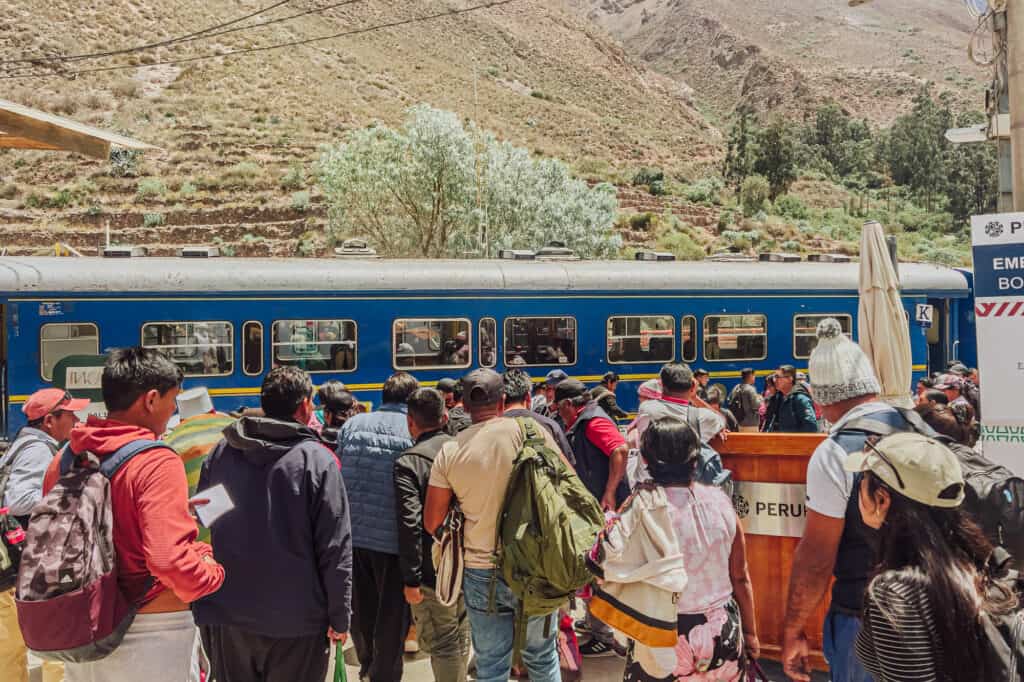
Ollantaytambo to Aguas Calientes
I prefer this option!
Rather than taking the train the whole way from Cusco, you could also take a bus or taxi from Cusco to the ancient Inca town of Ollantaytambo.
A driver will typically charge $50 USD, and the ride will take less than two-hours.
Ollantaytambo has its own train station, serving Aguas Calientes. The ride is 27 miles, and the train moves slowly at 40 kilometers an hour through the Urubamba River Valley.
- Duration: The train usually takes 1.5 hours to get from Ollantaytambo to Aguas Calientes.
- Booking: Again, book in advance if you’re visiting in June, July, or August.
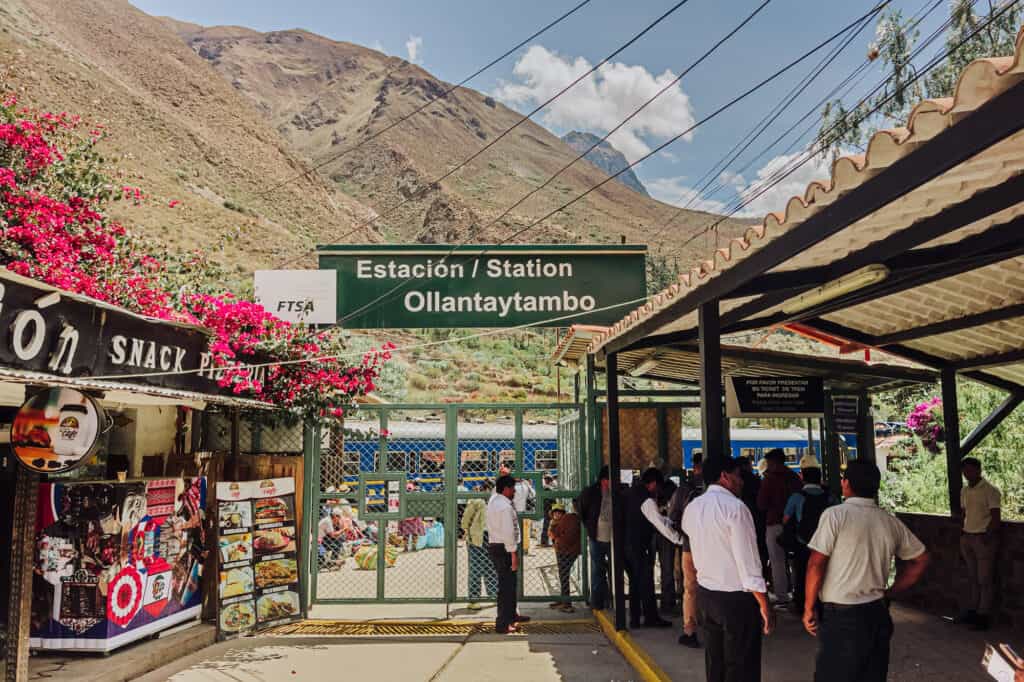
Food and Entertainment on the Train
Depending on the day, if you book the upgraded Vistadome tickets on PeruRail, you could be treated to a live-action play about Peruvian folklore, or a fashion show featuring fine alpaca garments.
They’ll hand out snacks, plus have wine and beer available for purchase.

There’s no WiFi on the trains, and cell service drops for much of the journey.
The Aguas Calientes Train Station
The train will drop you off right in Aguas Calientes. You’ll be able to walk from the train right to your hotel or rental.
The entry to the train station as you go to leave Aguas Calientes can be a bit confusing. You’ll have to wind your way through the adjacent market.

Follow the painted directions on the ground, which will lead you to the train ticket offices and platforms.
The Taxi to Aguas Calientes
It doesn’t exist! There are no taxis, and you can’t hire a driver to take you to Aguas Calientes.
There are no roads to Aguas Calientes, so all visitors and locals alike will have. rely on the train.
You might see a couple of small vehicles in town, but those were brought in on trains, too.
The only other vehicles you’ll see in Aguas Calientes are the buses, which are used to ferry tourists from the town up the hill to Machu Picchu.
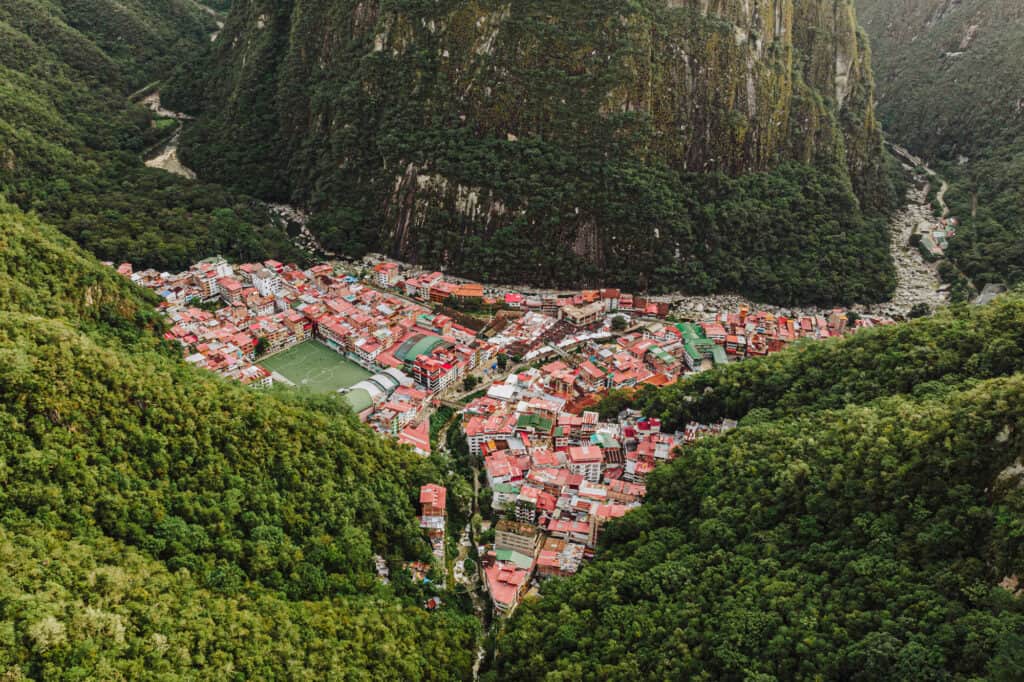
What to Expect in Machu Picchu Pueblo
Aguas Calientes primarily serves as a base for those visiting Machu Picchu, and its facilities are geared toward meeting the needs of tourists.
It’s a lively and bustling town, especially during the peak tourist months (June, July, and August).
Where is Aguas Calientes?
The town is in the Urubamba Province (Cusco Region) at the base of the mountains that surround Machu Picchu. It sits alongside the Urubamba River.
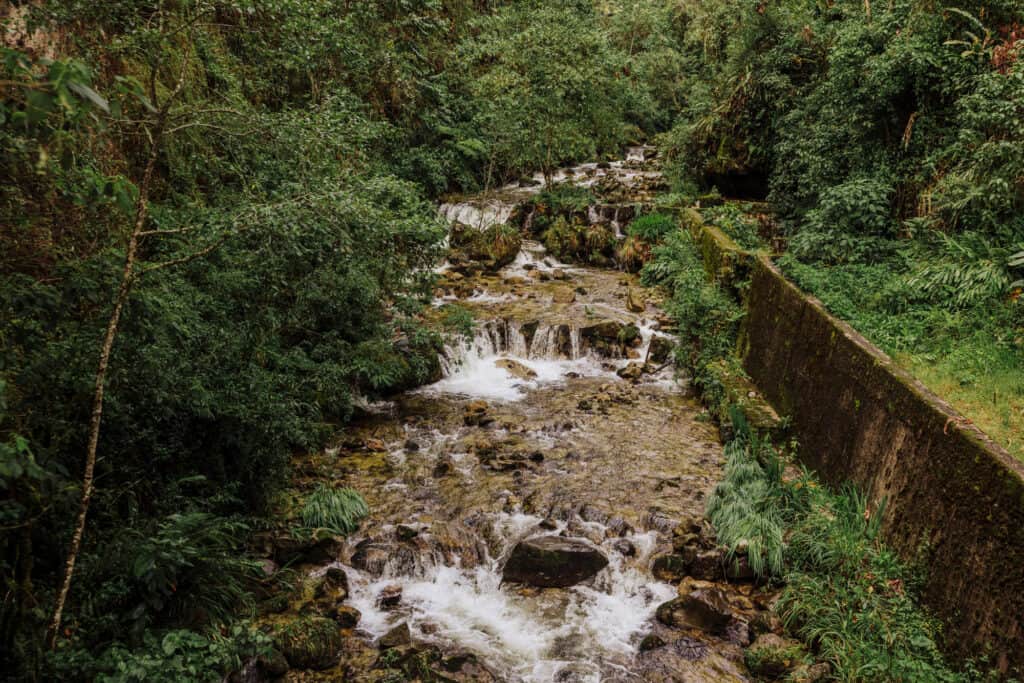
Aguas Calientes is approximately 70 miles northwest of Cusco.
The Elevation of Aguas Calientes
Aguas Calientes is about 6,700 feet (2,040 meters) above sea level, which is quite a bit below the elevation of many other tourist destinations in Peru!
Here are a few to compare it to:
- Machu Picchu: Approximately 7,970 feet (2,430 meters) above sea level.
- City of Cusco: Approximately 11,154 feet (3,400 meters) above sea level.
- Lake Titicaca (Puno): Approximately 12,467 feet (3,800 meters) above sea level.
- Ollantaytambo: Approximately 9,160 feet (2,792 meters) above sea level.
- Sacred Valley (Urubamba): Approximately 9,514 feet (2,900 meters) above sea level.
- Rainbow Mountain (Vinicunca): Approximately 16,466 feet (5,020 meters) above sea level.
- Humantay Lake: Approximately 13,779 feet (4,200 meters) above sea level.
- Moray: Approximately 11,549 feet (3,520 meters) above sea level.
What You’ll Find in Town
Here’s what visitors can expect, in addition to the buses to Machu Picchu:
- Accommodations: As mentioned Aguas Calientes offers a range of accommodations, including hotels, hostels, and lodges for people of all travel budgets.
- Restaurants and Cafes: The pedestrian-friendly streets are lined with restaurants and cafes offering a variety of cuisines. You can find traditional Peruvian dishes mixed in with American options.
- Hot Springs: The town is named “Aguas Calientes,” which translates to “hot waters,” from the natural thermal springs in the valley.
- Markets and Shops: Aguas Calientes is full of markets and vendors selling souvenirs, alpaca clothing, and more. In addition to gifts, make sure to stock up on SPF and bug repellent for your day at Machu Picchu!
- Tourist Information Centers: There are tourist information centers providing maps, and information about Machu Picchu, plus guides available for hire.
- Medical Facilities: Basic medical services are available in Aguas Calientes. You’re likely to see a few visitors limping around town, after hiking mishaps on their visit.
- Scenic Views and Surrounding Nature: The town itself is nestled in a valley, and just taking in the views of the surrounding mountains is a great way to relax and enjoy some downtime on a busy trip!

The markets and restaurants stay open well after dark, so you’ll never get bored on your visit.
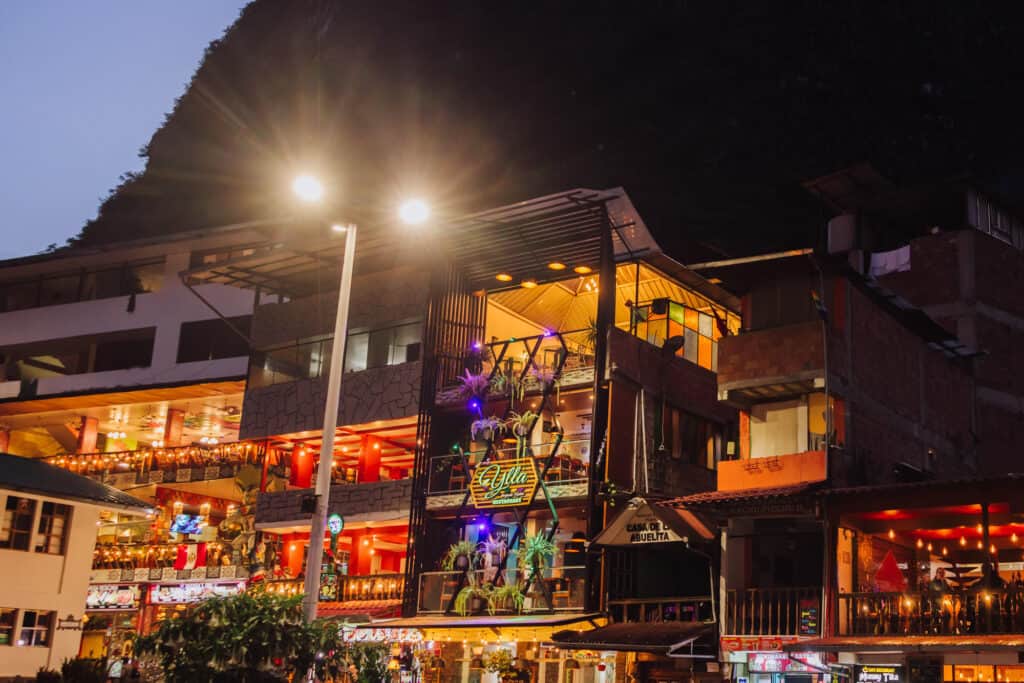
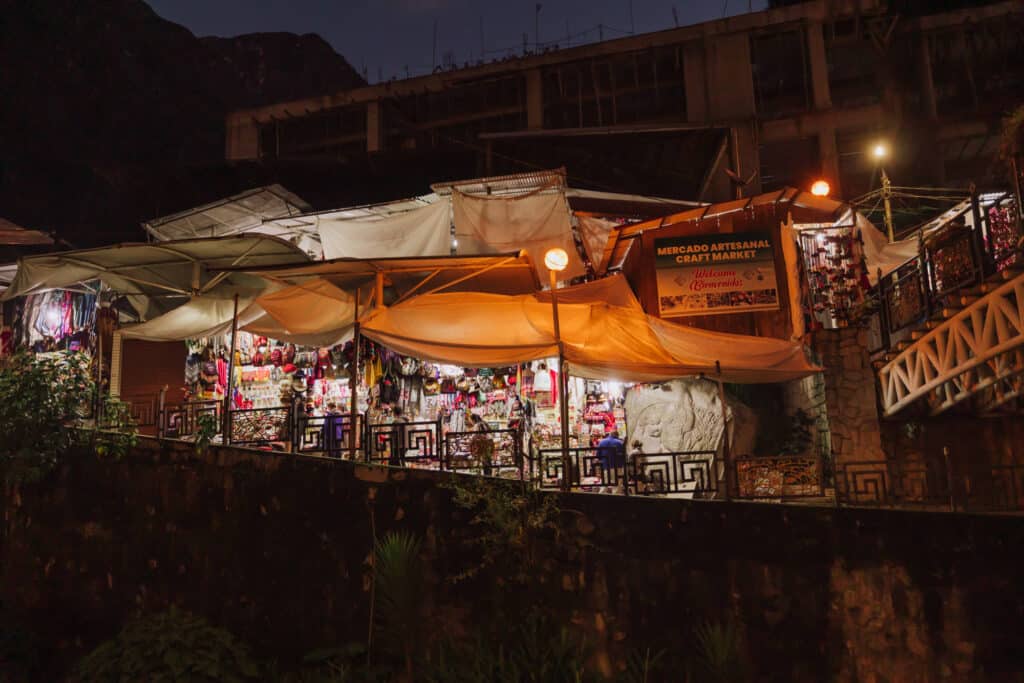
The Weather in Aguas Calientes Peru
Aguas Calientes has generally mild temperatures throughout the year.
Due to the surrounding mountains, weather conditions can change rapidly. Fog is common, especially in the morning, so regardless of the season, you should bring layers of clothing to wear.
Plus, pack a rain shell just in case the clouds open up! These ponchos are probably one of the biggest-sellers in town.

Here’s a breakdown of the weather in Aguas Calientes by month:
Dry Season (May to October):
- Daytime Temperatures: Typically 60°F to 70°F (15°C to 21°C).
- Nighttime Temperatures: Nights can be cool, with temperatures ranging from 40°F to 50°F (4°C to 10°C).
- Rainfall: Rainfall can be as low as 0.5 inches per month, especially in June, July, and August.
Transitional Months (November and April):
- Daytime Temperatures: Typically 60°F to 70°F.
- Nighttime Temperatures: Typically 40°F to 50°F.
- Rainfall: These shoulder season months mark the shift between the dry and wet seasons. Your days could be completely sunny, or you may have to deal with a few showers and some fog. Rainfall varies, from 1 to 5 inches per month.
Wet Season (December to March):
- Daytime Temperatures: Typically mild still, from 60°F to 70°F.
- Nighttime Temperatures: Still above freezing, and usually 40°F to 50°F (4°C to 10°C).
- Rainfall: Precipitation ranges from 5 to 10 inches per month. December and January tend to be the wettest months.
A visit in the wet season likely won’t be a total washout. I’ve been to Machu Picchu in January, and dealt with some rain but we still had a great time. Plus, watching the fog lift and move across the valley is a beautiful site.
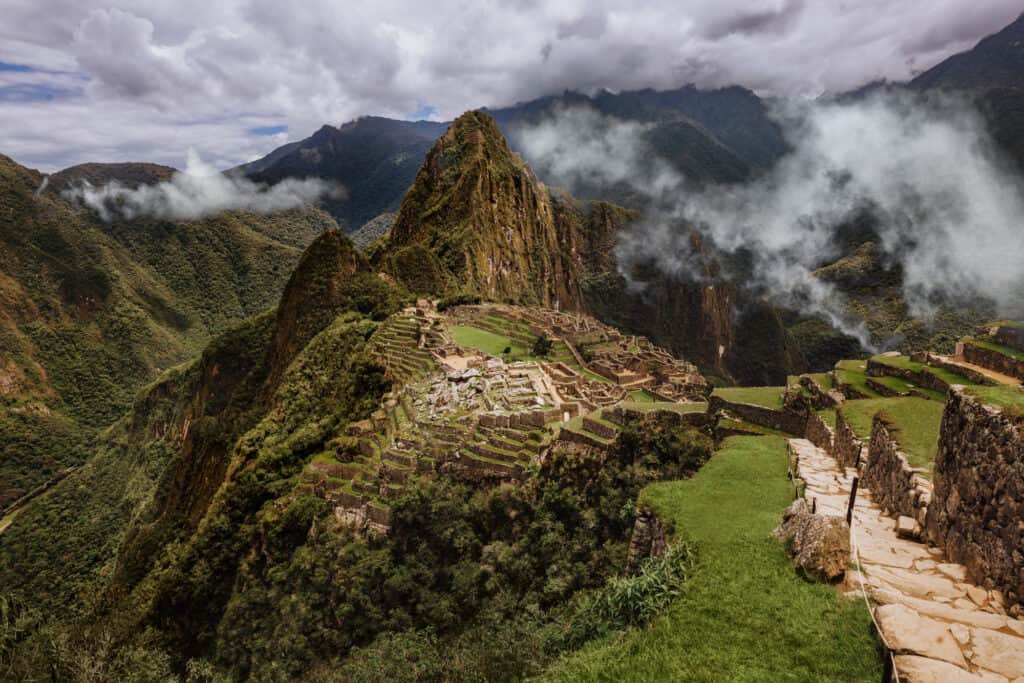
Hike to Machu Picchu Pueblo
Both the Inca Trail and the Lares Trek offer unique experiences in the Peruvian Andes, leading to Machu Picchu. Each will take several days.
I’m keeping this section short, because you’ll almost certainly be part of a guided tour if you’re hiking to Machu Picchu.
➡️ Click to Book: Inca Trail (4-days)
- Includes the guide, food, entry, and transportation.
➡️ Click to Book: Inca Trail (2-days)
- A shorter version, for travelers with less time.
- Includes guides, porters, food, entry, and transportation.
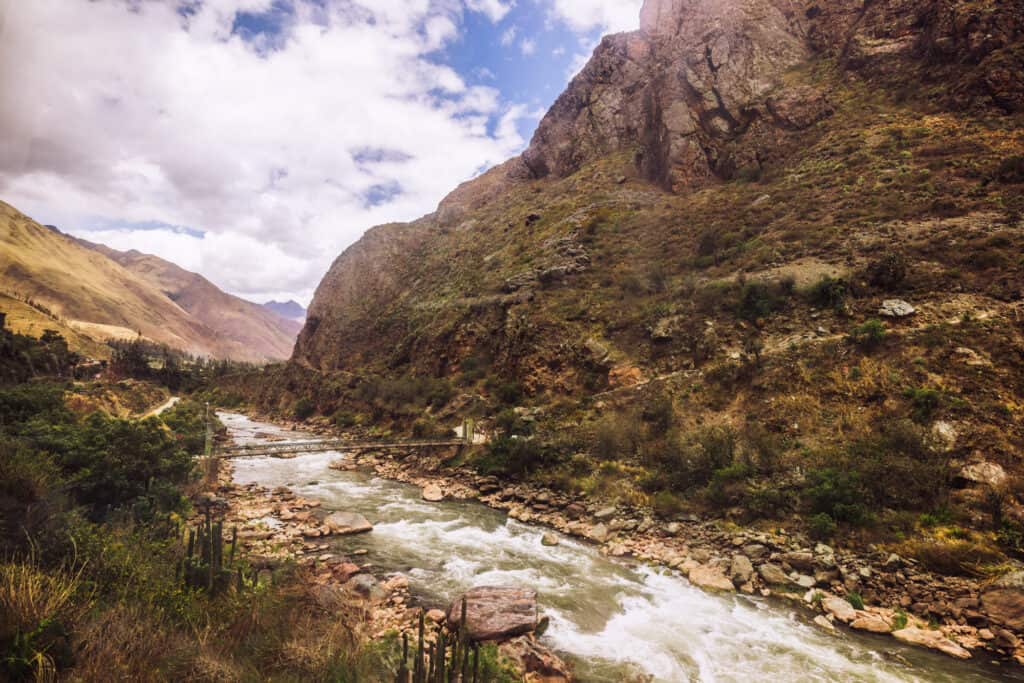
The Inca Trail
The Inca Trail is the most famous trekking route to Machu Picchu and is renowned for its historical significance. It follows the original stone-paved path built by the Incas centuries ago.
Starting on a bridge over the river just beyond Ollantaytambo, the Inca Trail provides a diverse range of landscapes. Over the course of 4-days, you’ll pass through cloud forests, alpine meadows, and subtropical jungles.
Due to its popularity, permits are limited, and you’ll need to go with a guide on the Inca Trail.
It ends at the Sun Gate, which delivers the first views of Machu Picchu to hikers as they wrap up their trek.
The Lares Trek
The Lares Trek offers a more immersive cultural experience as it passes through remote Andean villages. Compared to the Inca Trail, the Lares Trek is less crowded, providing a more tranquil and off-the-beaten-path experience.
Permits are generally more readily available, making it a good alternative for those who can’t secure Inca Trail permits.
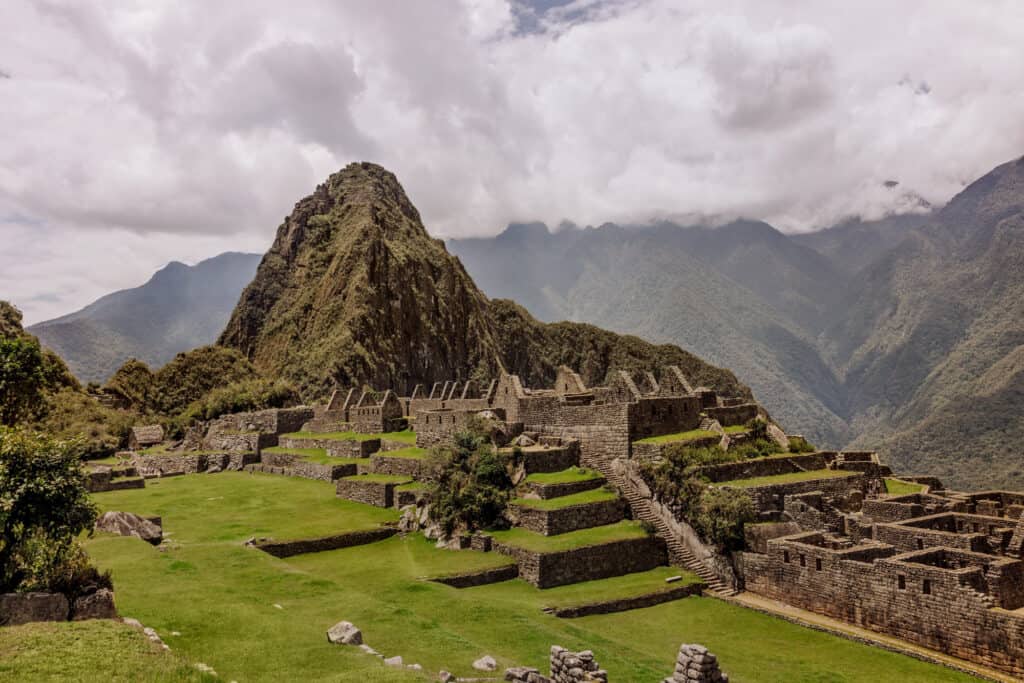
Hot Springs in Aguas Calientes
The name “Aguas Calientes” translates to “hot waters” in English, and is derived from the natural hot springs in the area.
While the town is officially known now as Machu Picchu Pueblo, it’s still commonly referred to as Aguas Calientes due to the presence of these thermal springs.
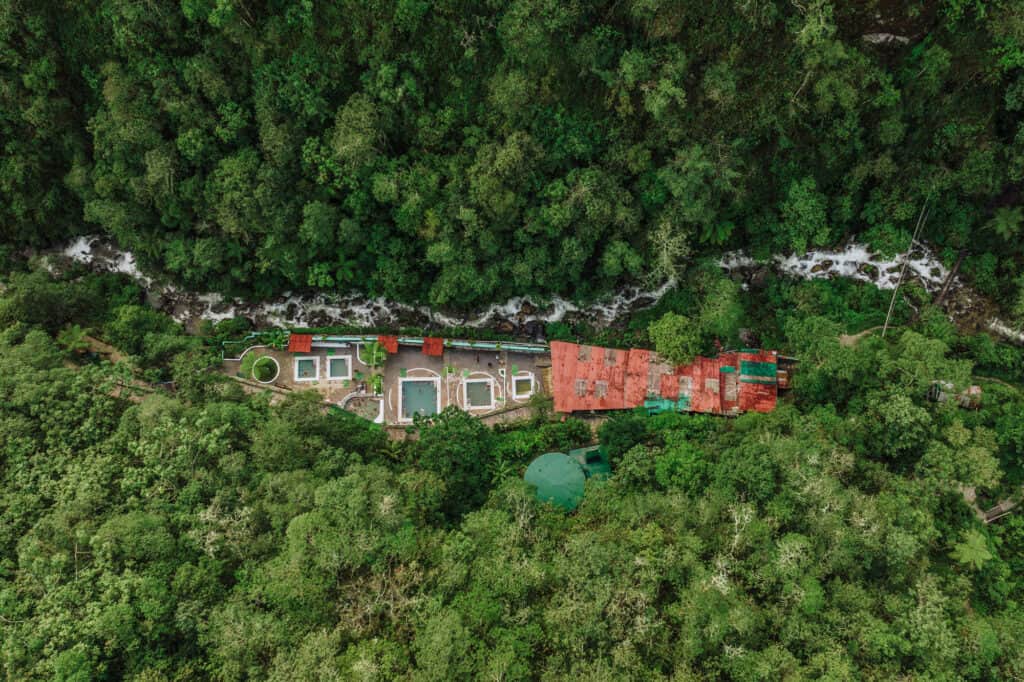
You’ll see in town: the thermal waters are billed as a way to relax and unwind after a day at Machu Picchu.
Banos Termales and Aguas Termales feature pools of thermal water, which will be 97 to 99 degrees Fahrenheit.
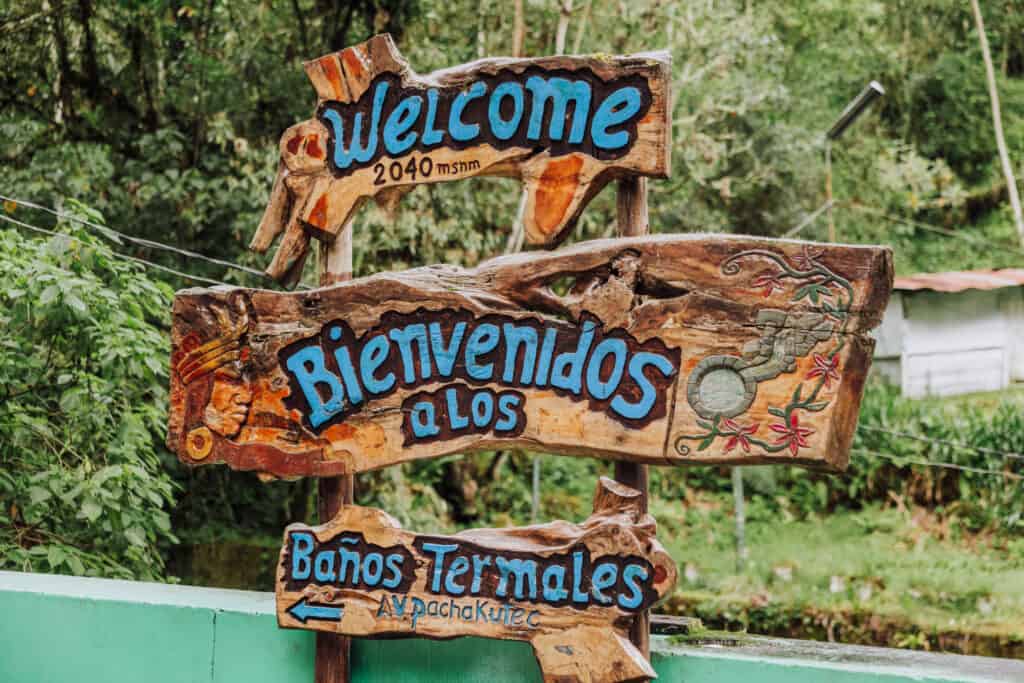
We paid about $10 each to enter.
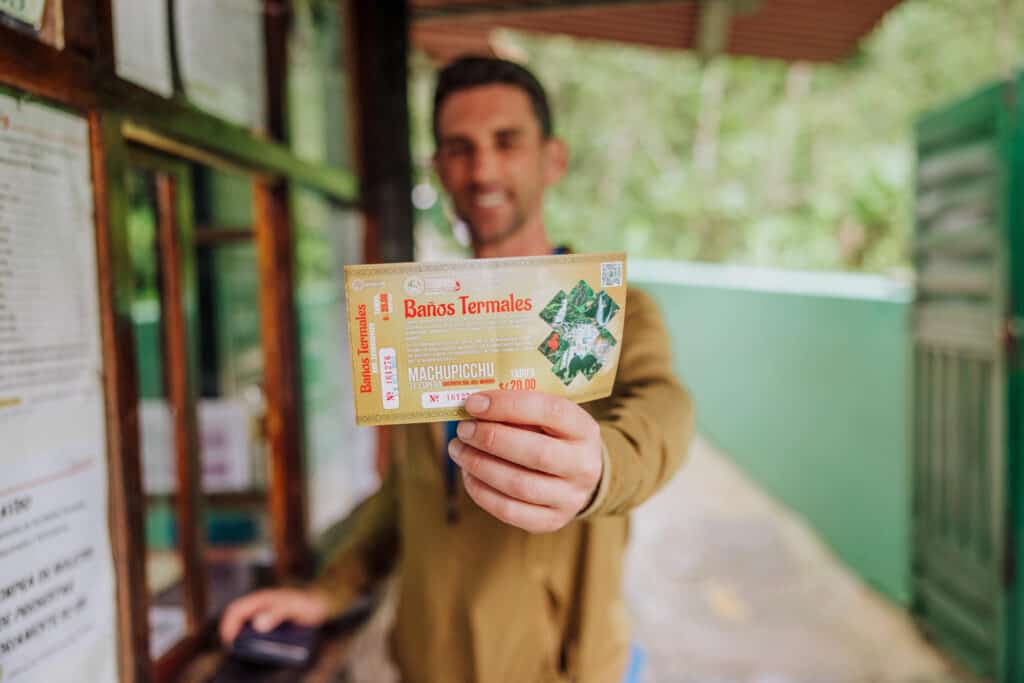
Only swimwear, towels, and flip-flops are allowed. There’s also a small restaurant overlooking the pools below.
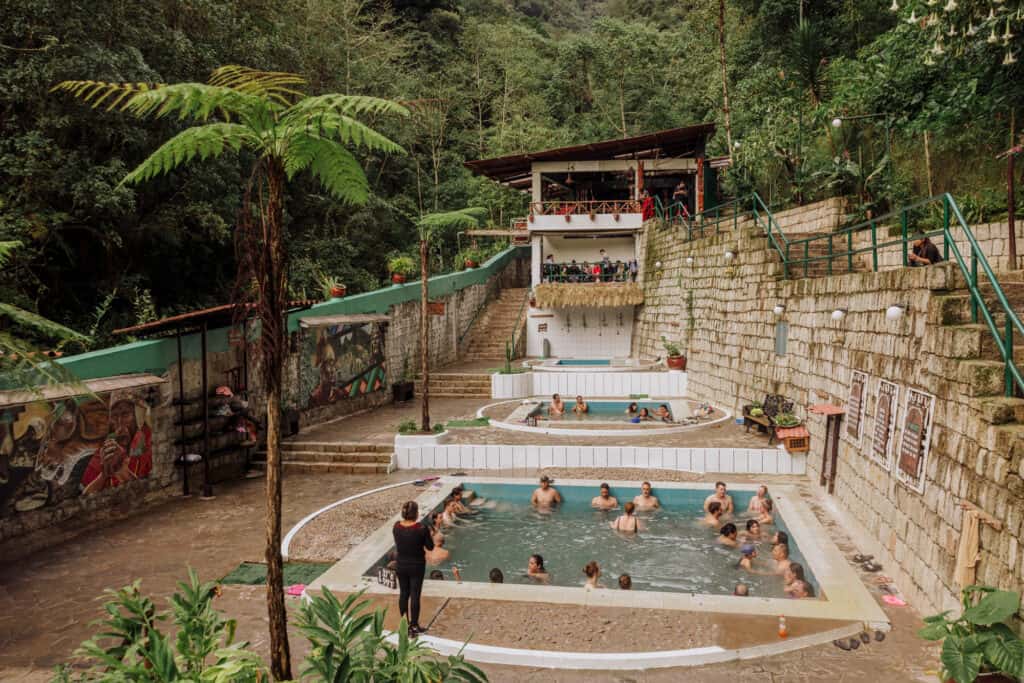
The hot springs are open from 6:00am to 10:00pm during the height of the tourist season, but hours are usually cut during the rainier part of the year.
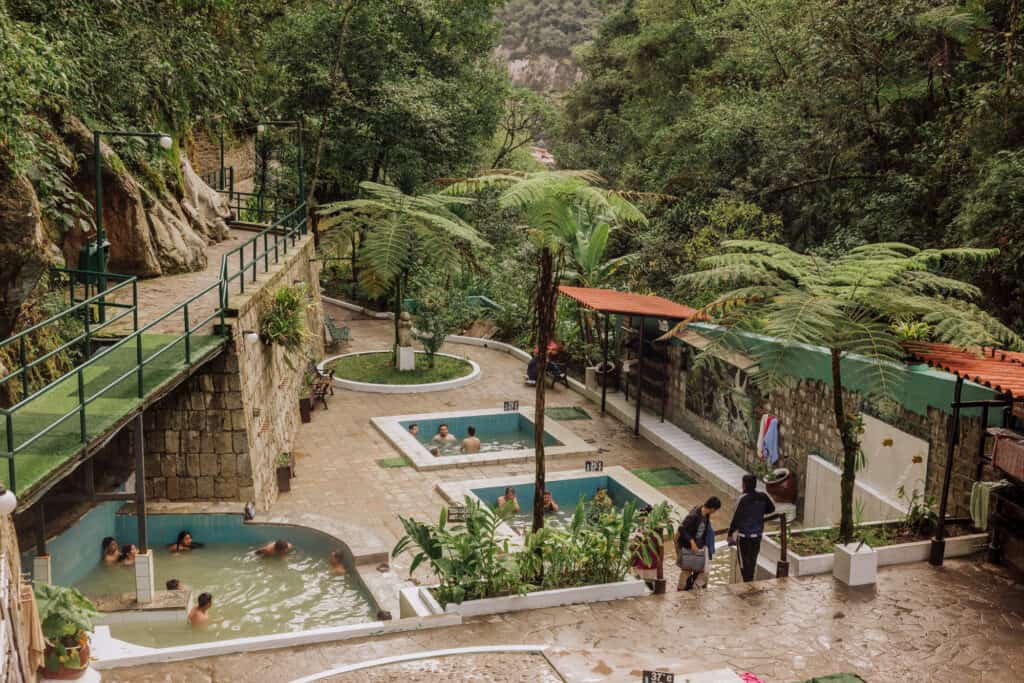
Waterfalls in Aguas Calientes
If you keep walking up the hiking path beyond the hot springs, you’ll come to a beautiful waterfall.
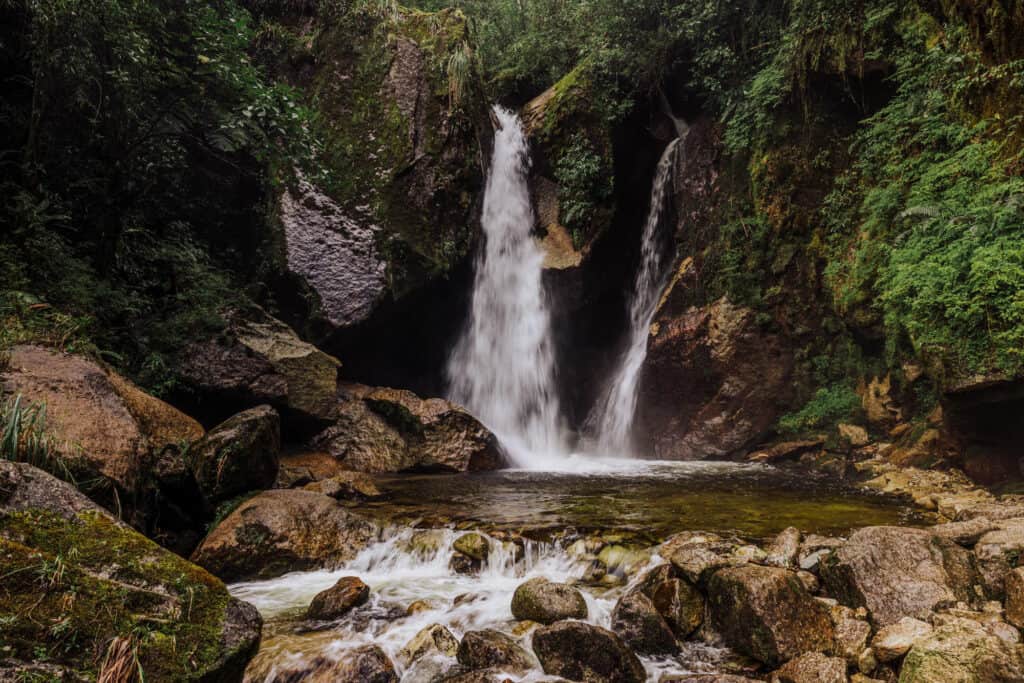
A dip in the swimming hole here, while colder, is a much better way to spend some time (in my opinion)!
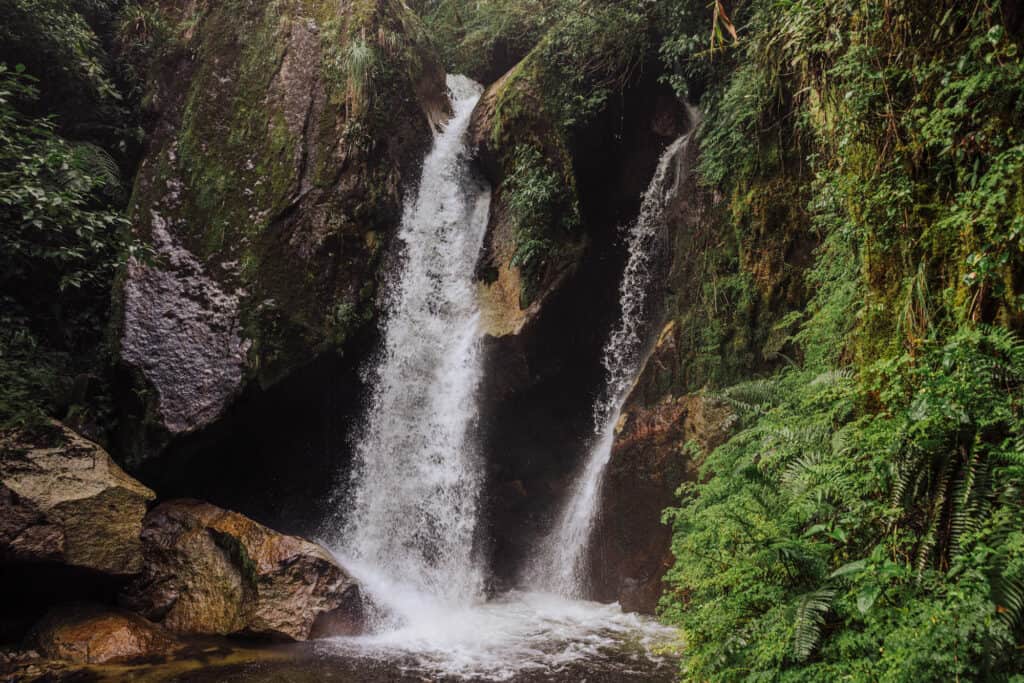
Food and Restaurants
The steep, pedestrian-friendly streets in Aguas Calientes are lined with dozens and dozens of restaurants and cafes.
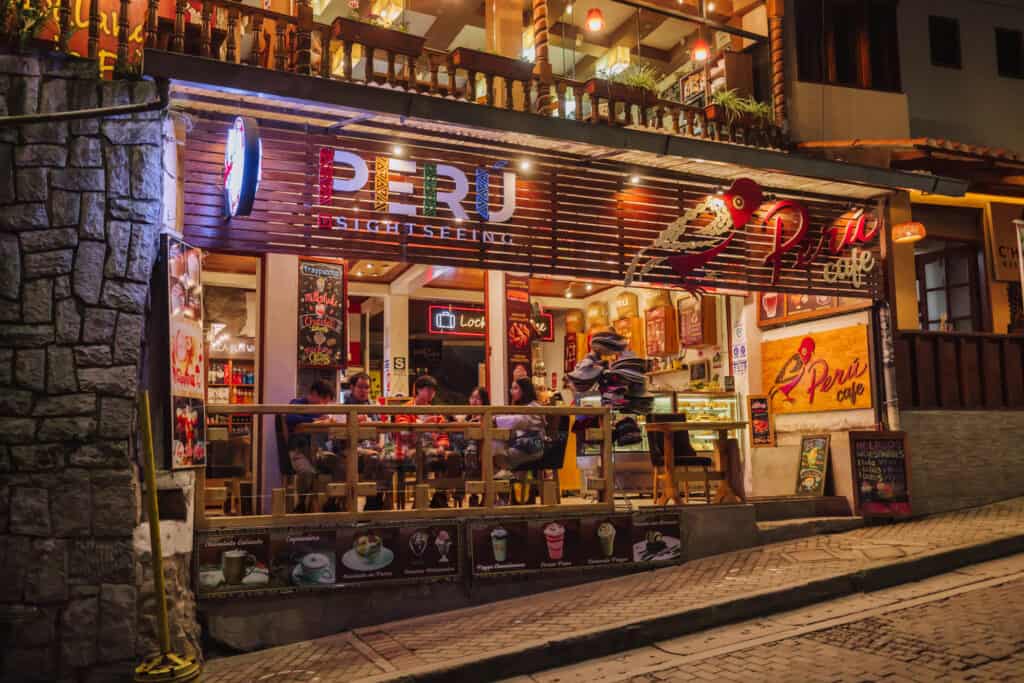
Some sell crepes and coffee, some sell pizza and burgers, and others sell more traditional Peruvian food.

Expect a meal to take an hour or more. They don’t rush things, and the waiters won’t bring your bill until you eventually ask for it.
Many, or most, have outdoor dining options on their streetside patios.
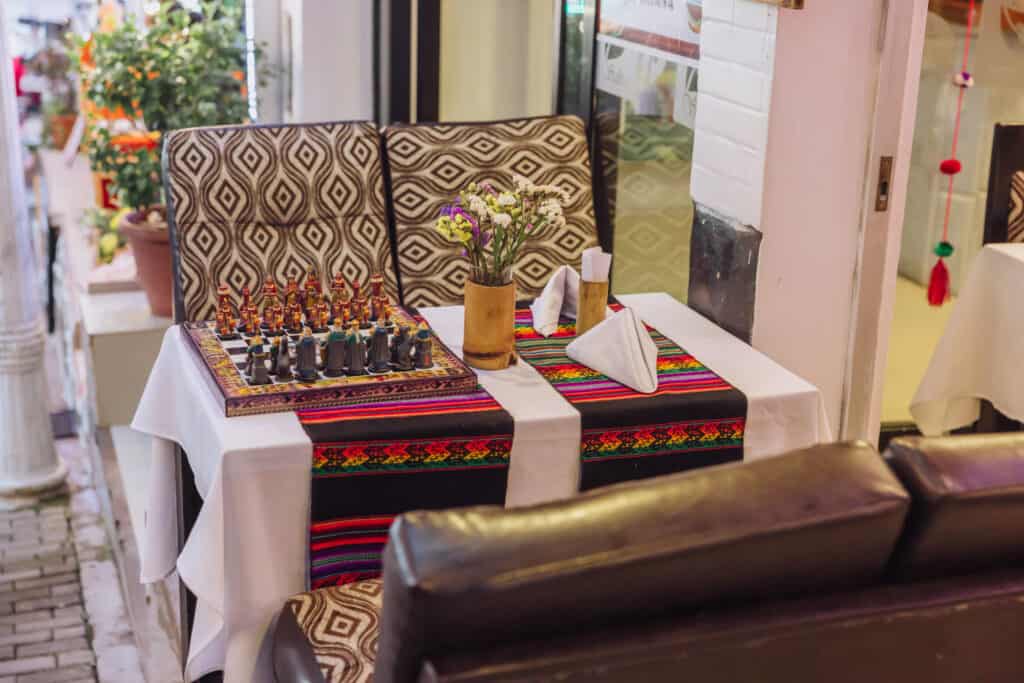
Peruvian cuisine is known for its diverse flavors and unique combinations influenced by indigenous ingredients and Spanish, African, Asian, and even Italian culinary traditions.
Here are some traditional Peruvian dishes you might find on the menu in Aguas Calientes:
- Ceviche: Although Aguas Calientes is in the mountains and not near the coast, some restaurants may offer a version of ceviche, a dish typically made with raw fish cured in citrus juices and mixed with various spices.
- Lomo Saltado: A popular Peruvian stir-fry dish that typically includes strips of beef, onions, tomatoes, and other vegetables, flavored with Peruvian spices and served with rice.
- Aji de Gallina: Shredded chicken in a creamy, spicy yellow pepper sauce, often served with potatoes and rice.
- Quinoa Soup: Quinoa is a staple in Peruvian cuisine, and a hearty quinoa soup with vegetables and sometimes meat is a common dish.
- Anticuchos: Grilled skewers of marinated meat, often beef heart, served with potatoes or other accompaniments.
- Alpaca or Guinea Pig Dishes: These are traditional meats in the region, and you might find dishes featuring alpaca or cuy (guinea pig) in some restaurants.
- Inca Kola: A popular Peruvian soft drink known for its bright yellow color and unique flavor.
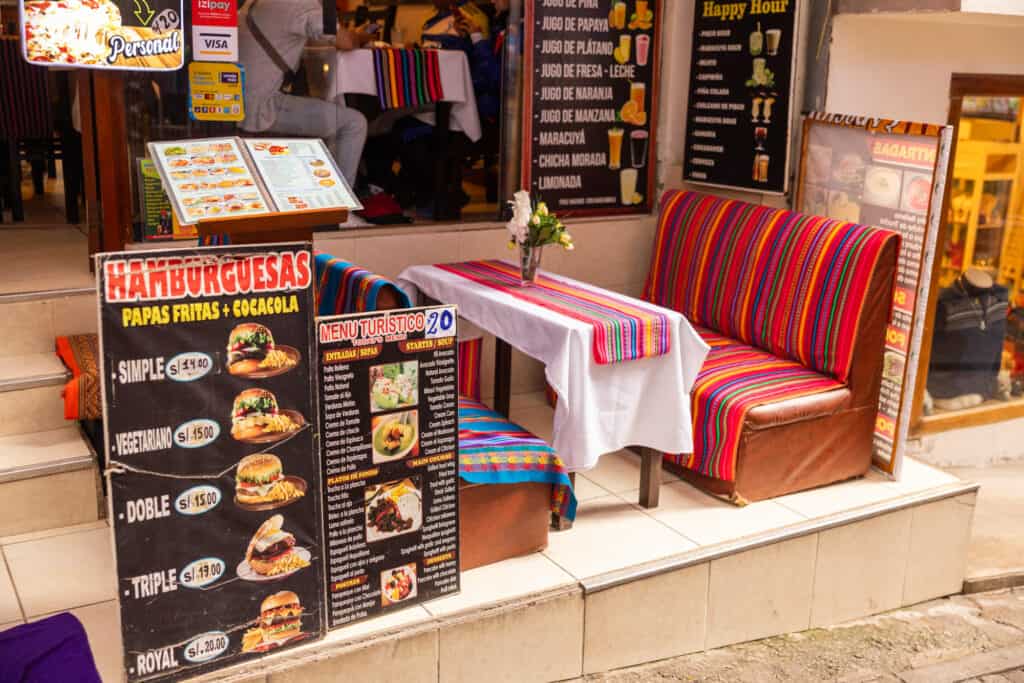
Aguas Calientes to Machu Picchu
Since there are no cars or taxis, everyone has two choices: hike or take the bus from Aguas Calientes to Machu Picchu.
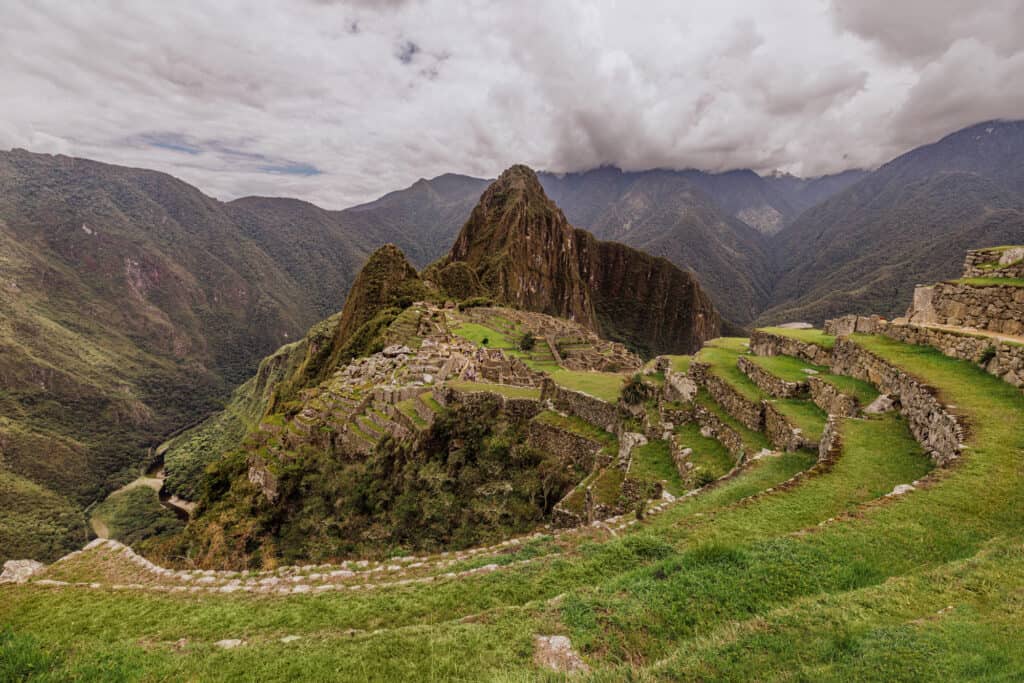
The hike begins by following the main road down along the river. You’ll cross a bridge, and find the sign marking the start of the trail.
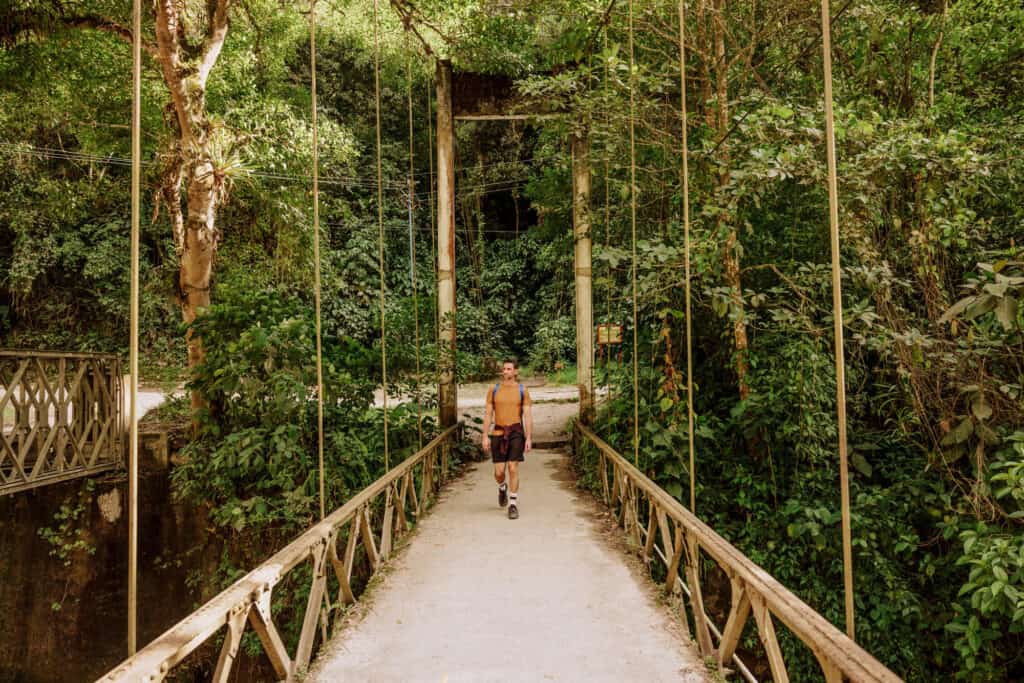
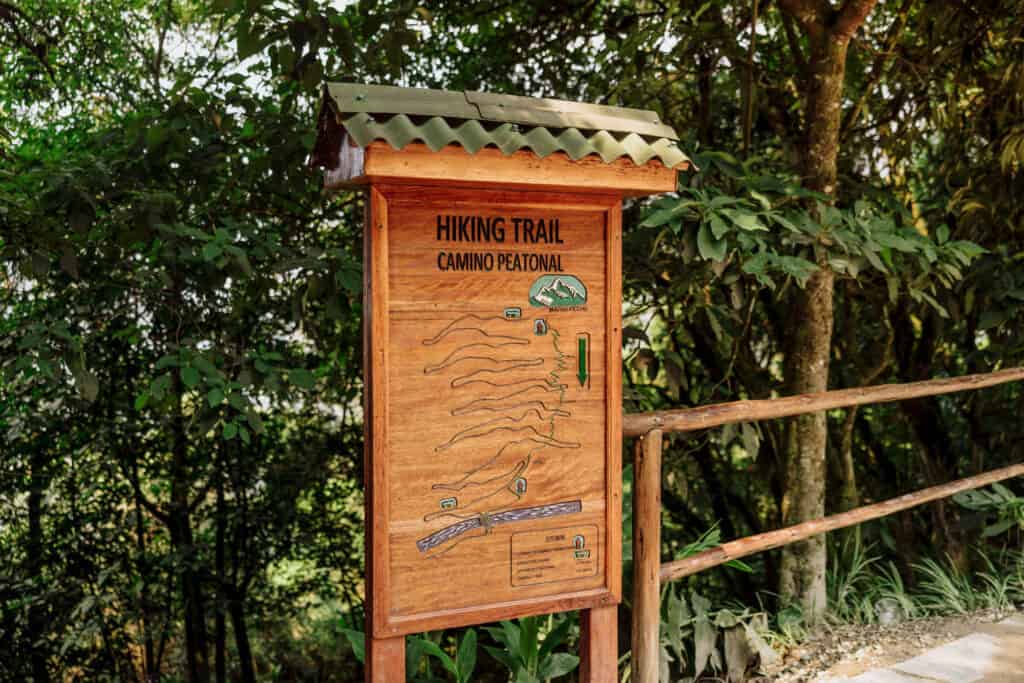
A warning: the hike up from Aguas Calientes to Machu Picchu is steep! Personally, I’d suggest taking the bus up to Machu Picchu, and then (weather permitting) hike back down to town.
The Bus in Aguas Calientes
The ticket office in town is right off the main street and easy to find. Make sure to bring your passport when you buy your tickets!
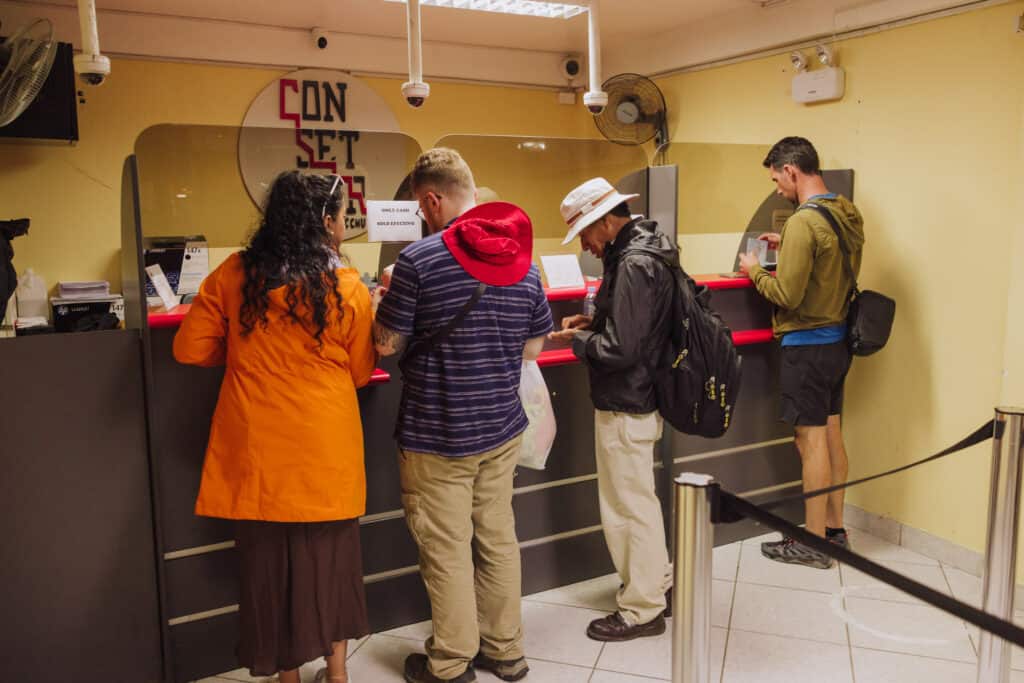
You’ll have two purchase options:
- A one-way bus ticket for about $12 USD
- A roundtrip bus ticket for about $20 USD
If you’re unsure about whether you’ll ride the bus up and hike down, you can always buy a return ticket at the exit of Machu Picchu after you explore the site.
The bus situation seems chaotic at first, but they haul 2,500 tourists up to Machu Picchu daily, so they have it pretty well-organized.
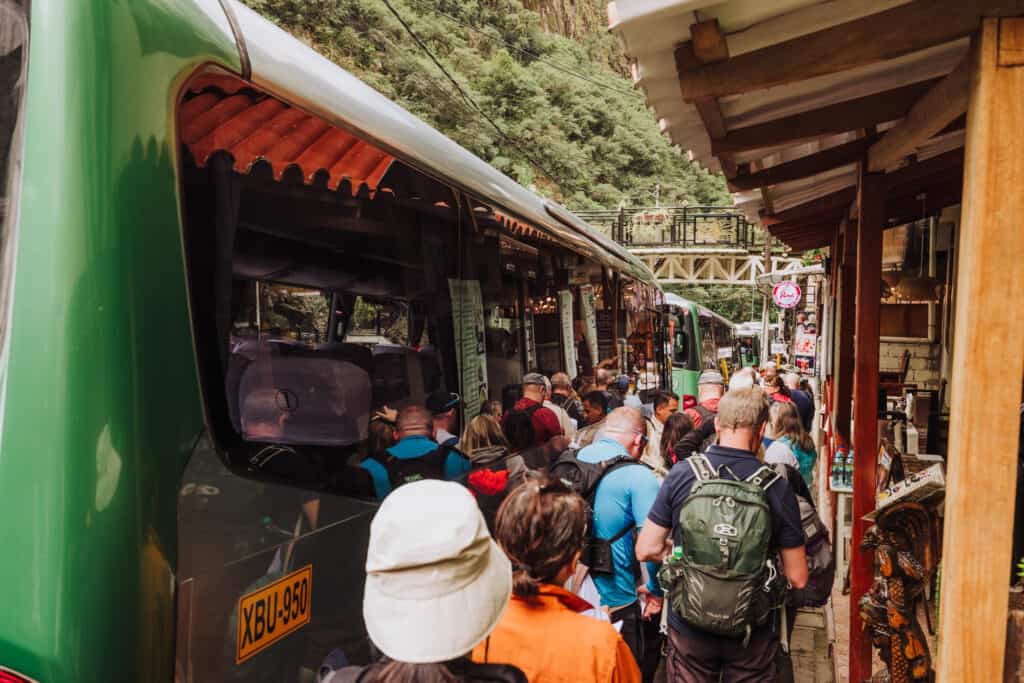
It’s easiest if you arrive in Aguas Calientes the day before your reservation for Machu Picchu.
Here’s an anecdotal example of how you’d take the bus for an 11:00am reservation to Machu Picchu:
- Buy your bus ticket the night before
- If you arrive in Aguas Calientes the day-of, get there by 9:30am
- Line up for the bus at 10:00am
- Bus departs at 10:20am
- Arrives at Machu Picchu at 10:45am
The bus ride gets mixed reviews, but the drivers have slowed down since the post-pandemic reopening. You’ll still ride along steep cliffs, on a road that zig-zags up the mountain.
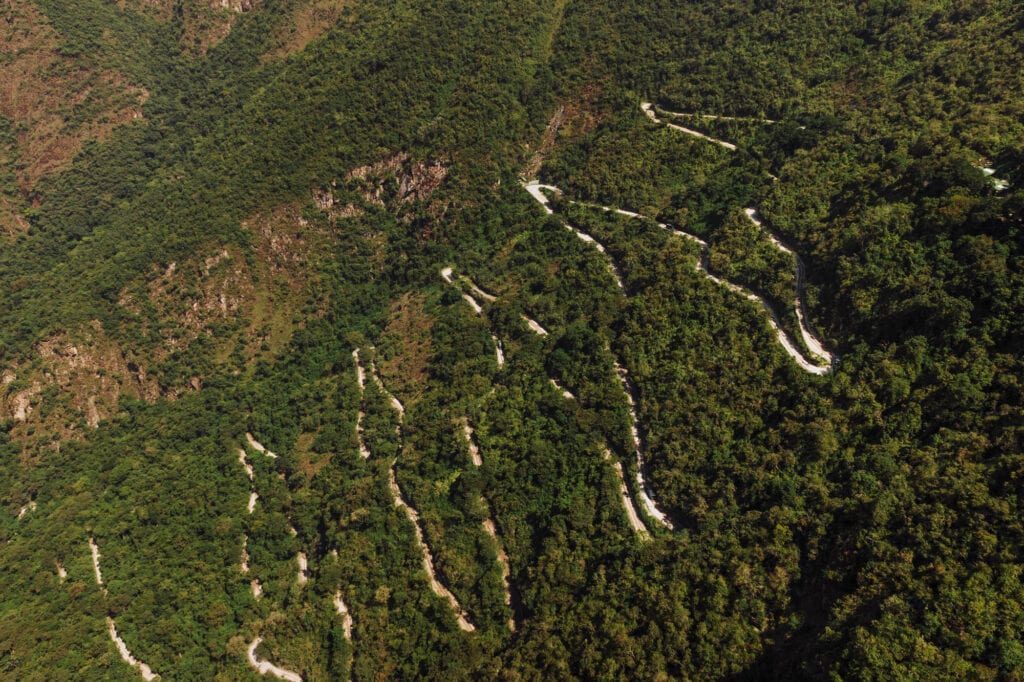
Aguas Calientes to Ollantaytambo
After your visit to Machu Picchu, and after your time in Aguas Calientes has come to an end, I’d really recommend taking the train to Ollantaytambo.
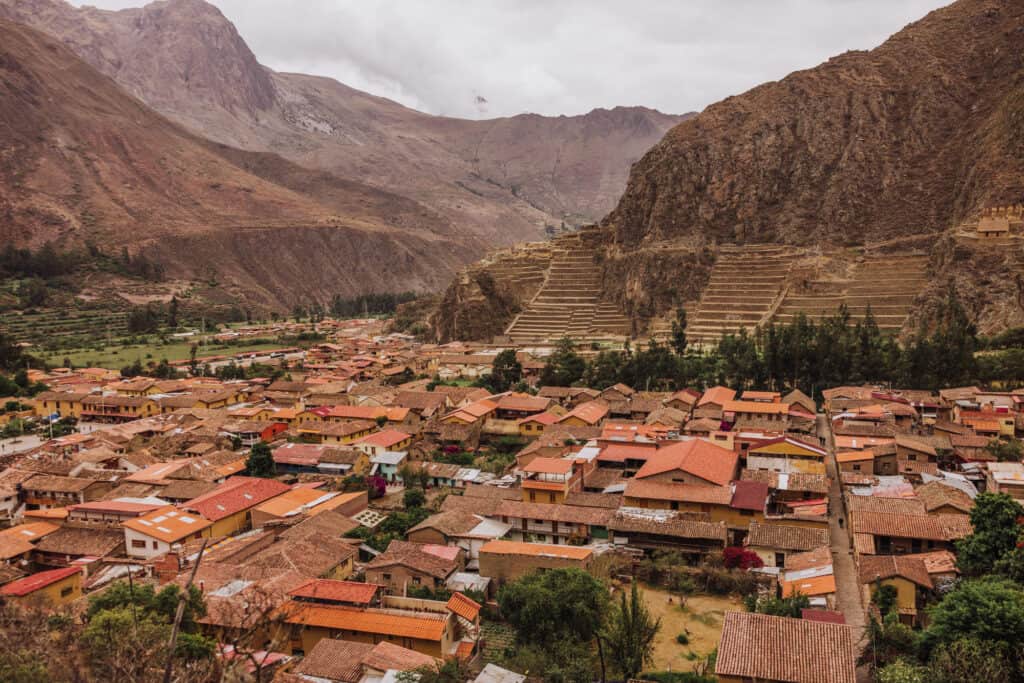
If you didn’t spend a day in the Inca town on the front end of your trip, it’s worth a day after Machu Picchu.
You’ll find several draws, making it worth at least a day on your trip to Peru:
Ollantaytambo’s Inca Ruins
- Ollantaytambo is home to well-preserved Inca ruins that showcase impressive stonework and architecture. The Ollantaytambo archaeological site includes terraces, temples, and a fortress, providing a glimpse into the strategic and religious significance of the area during the Inca Empire.
- Visible from the town, the Pinkuylluna Mountain Granaries are ancient Inca storage structures built into the mountainside. A hike to these granaries offers not only historical insights but also panoramic views of Ollantaytambo and the valley.
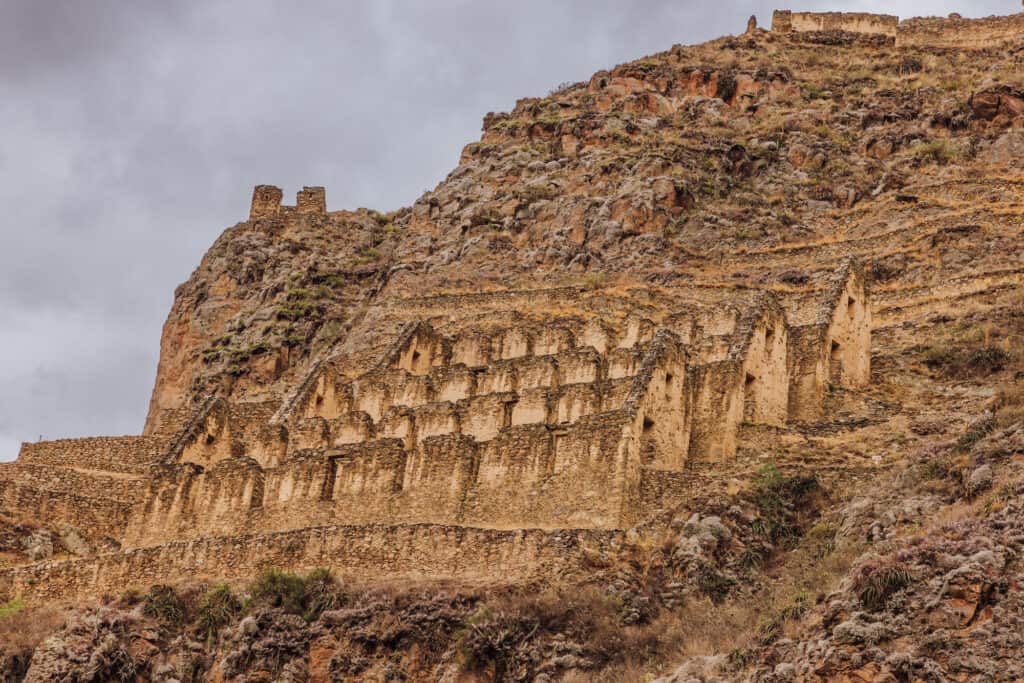
Ollantaytambo: A Living Inca Town
- Ollantaytambo is considered one of the oldest continuously inhabited towns in South America. Its layout and structures maintain a distinct Inca influence, creating a unique atmosphere that allows visitors to step back in time.
- The town’s layout and narrow cobblestone streets have retained their original Inca urban planning. The Spanish colonial architecture that followed the Inca period is also present, creating a blend of historical styles.
- Ollantaytambo hosts vibrant local markets where visitors can experience the local culture and purchase traditional handicrafts, textiles, and souvenirs. The markets offer an opportunity to interact with local artisans and vendors.
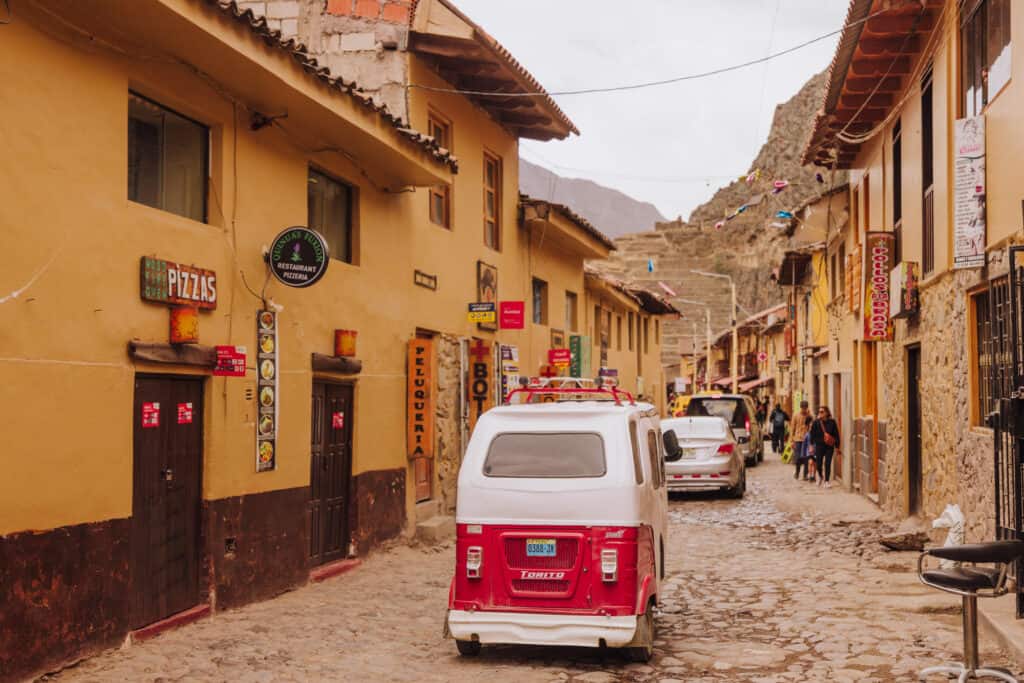
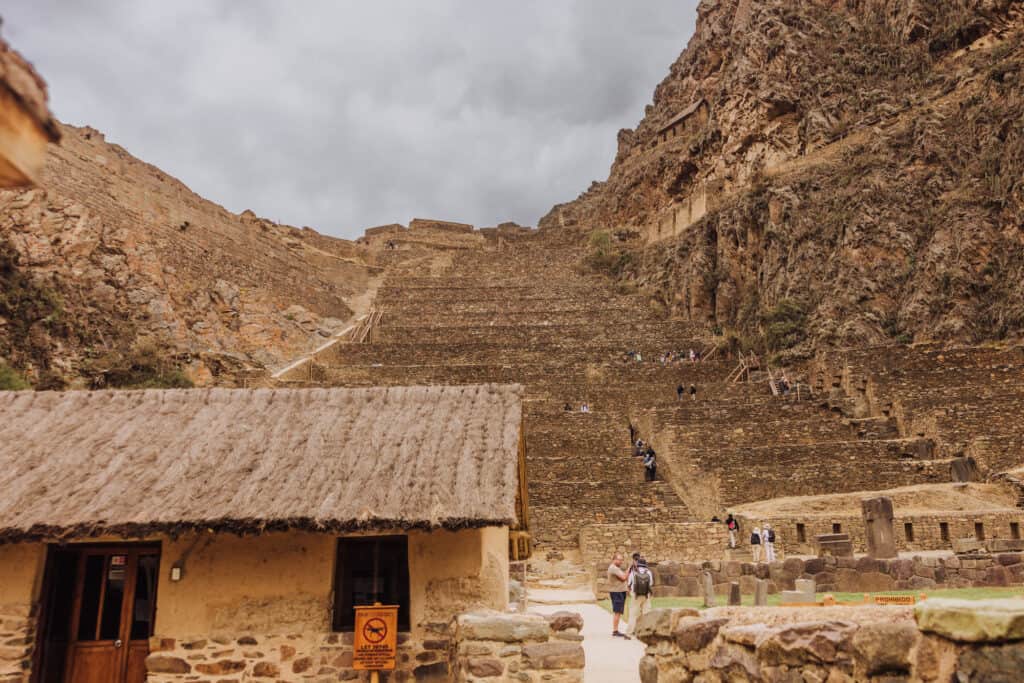
The History of Aguas Calientes Peru
Before the arrival of the Spanish, the region around Machu Picchu was inhabited by indigenous peoples. There’s no historical evidence suggesting a significant permanent settlement existed in present-day Aguas Calientes.
Aguas Calientes Develops in the 20th Century
- The story of Aguas Calientes begins in the early 20th century when American historian and explorer Hiram Bingham rediscovered Machu Picchu in 1911.
- The town of Aguas Calientes began to take shape as a base for tourists visiting Machu Picchu. Given its proximity to the archaeological site and the presence of hot springs (aguas calientes), it became a natural choice for those exploring the wonders of Machu Picchu.
- The town’s infrastructure developed to accommodate the increasing number of visitors to Machu Picchu.
- The construction of the railway from Cusco and Ollantaytambo to Aguas Calientes facilitated access for tourists.
- Hotels, restaurants, and various services catering to tourists emerged to meet the growing demand.
- In recent years, there have been efforts to balance the town’s growth with sustainable tourism practices and environmental conservation. Authorities have implemented measures to regulate the number of visitors to Machu Picchu and to preserve the site and its surroundings.
- In 2011, the Peruvian government officially changed the name from Aguas Calientes to Machu Picchu Pueblo, emphasizing its connection to the world-renowned archaeological site.
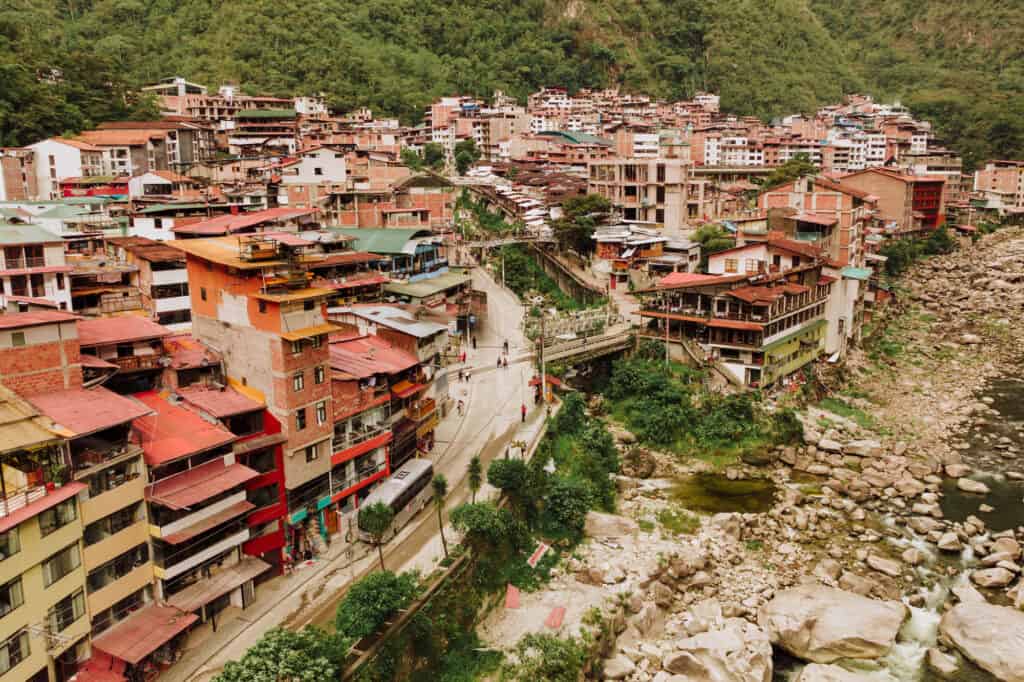
FAQs About Aguas Calientes Peru
Let’s review some of the frequently-asked-questions about Aguas Calientes. Many of these have already been answered above.
Can you drive to Aguas Calientes?
No, there are no roads to Aguas Calientes, so you won’t be able to drive yourself or hire a taxi. The train from Cusco or Ollantaytambo is the only way to get to Machu Picchu Pueblo.
How far is Aguas Calientes from Machu Picchu?
The bus ride up the hill from town will take about 25 minutes.
If you choose to hike down, we clocked around 8,000 steps and roughly 4-miles. It takes an hour or two, depending on how quickly you go.
Is Aguas Calientes safe?
You’ll feel very safe walking the streets, day or night. They’re busy with tourists late into the night, and bustling again very early in the morning.
Most streets are closed to traffic, so it’s all very pedestrian-friendly.
What’s the altitude of Aguas Calientes?
The town sits at about 6,700 feet above sea level, putting it much lower than other popular destinations in Peru, like the city of Cusco and Rainbow Mountain.
Machu Picchu is about 8,000 feet above sea level.
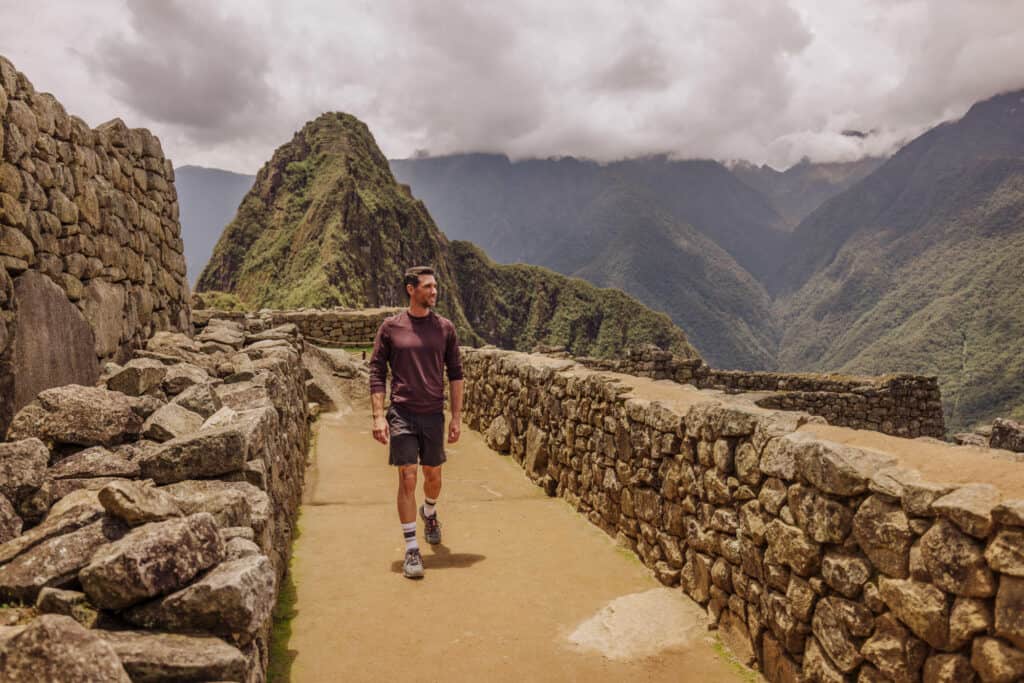
Wrap: Stay in Aguas Calientes at Least One Night!
Aguas Calientes is surrounded by lush green mountains, mist-covered peaks, and the rushing Urubamba River.
While the town’s namesake “hot waters” (hot springs) are its least enjoyable attraction, the narrow pedestrian-friendly streets, abundance of hotels and restaurants, and natural beauty are more than enough of a reason to spend a couple of days here.
I’d also be remiss if I didn’t mention one of my favorite parts of Aguas Calientes: the seemingly well-fed, friendly street dogs in town.

Rather than taking the train the whole way, my favorite way to get to Aguas Calientes from Cusco is:
- hiring a driver to Ollantaytambo
- taking the train from Ollantaytambo to Machu Picchu Pueblo
Aguas Calientes may be small, but it offers a glimpse into local Peruvian life, and will be a memorable part of any trip to Machu Picchu.
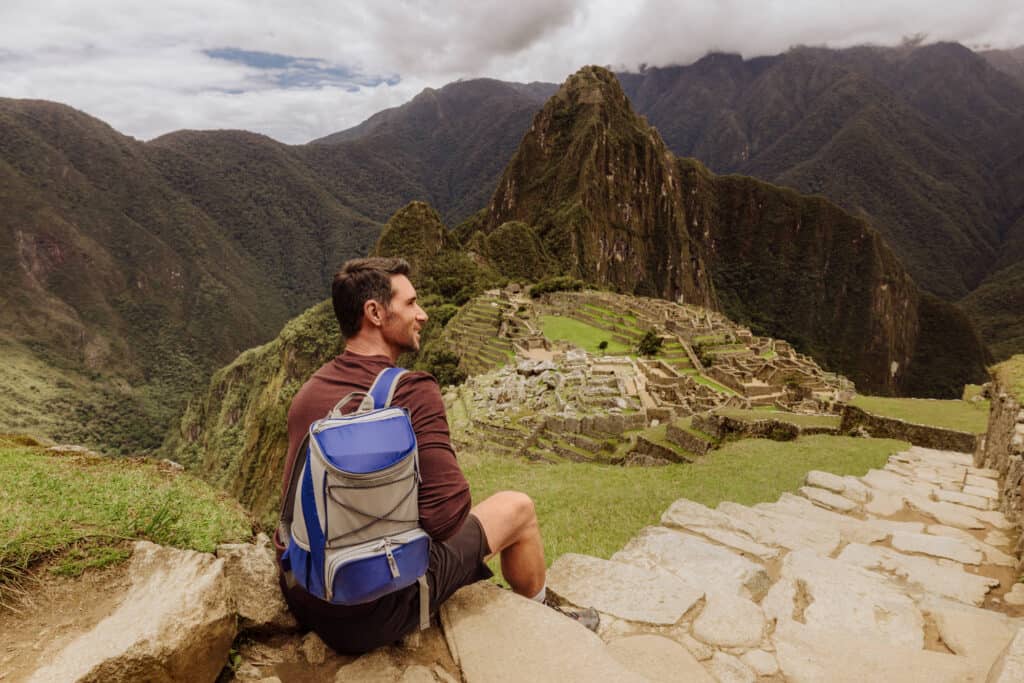
Check out our other posts about the Cusco region of Peru!
🇵🇪 Pallay Punchu: The New Rainbow Mountain
🇵🇪 The Best Time to Visit Machu Picchu
🇵🇪 Moray
